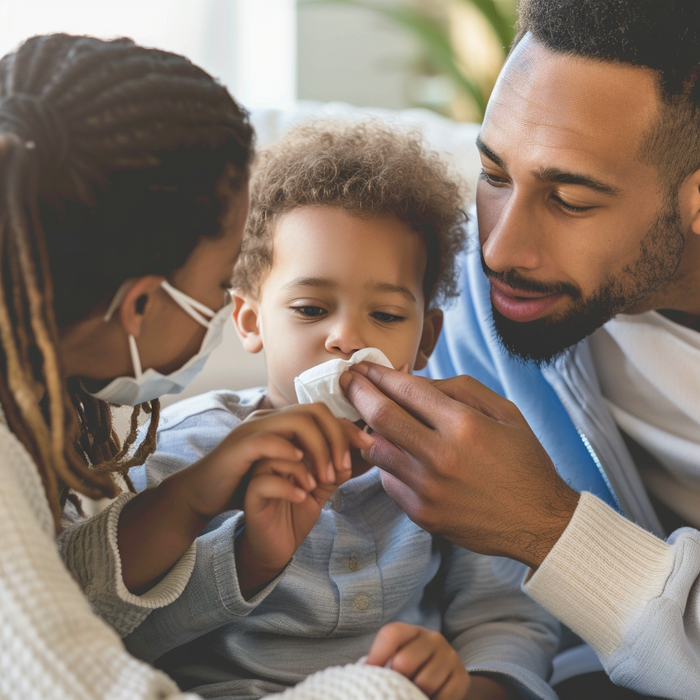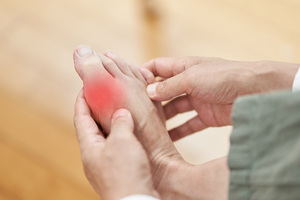Key points
- Nosebleeds are common, usually harmless, and can be treated at home.
- Techniques to stop a nosebleed include staying calm, leaning forward, staying upright, using a medicated nasal spray, and pinching the nostrils closed.
- Frequent nosebleeds, symptoms of blood loss, or nosebleeds in children under 2 years old may require medical attention.
- Prevention methods include keeping the nose moist, avoiding nose picking, and using a humidifier.
- Nosebleeds are slightly more common in children between 2 and 10 years, elderly adults, pregnant women, people on blood-thinning medications, and those with blood clotting disorders.

Nosebleeds (also called “epistaxis” in the medical community), are usually not a cause for concern. They often happen during particularly dry months of the year (like winter), and if you have a small injury to the nose (from nose picking or nose blowing). Taking a hit to the nose (common in sports and among children who play) can also cause a bloody nose.
Although nosebleeds may seem frightening (especially if you’ve never dealt with one before), there are easy ways to treat them at home.
9 Steps to Stop a Bloody Nose
A bloody nose is a common and usually fast problem you can handle at home with the following steps:
- Stay calm - Everyone experiences a nosebleed at some point, and the American Academy of Family Physicians (AAFP) notes that they usually stop quickly and aren’t a sign of serious trouble.
- Lean forward - Leaning forward will help you avoid swallowing blood which can upset your stomach, according to the University of Michigan.
- Stay upright - Lay down will cause the blood to travel backward, down your throat, according to the University of Michigan. To avoid this, they recommend staying upright until after your nosebleed stops.
- Try a medicated nasal spray - A medicated nasal spray can help stop a nosebleed, according to the University of Michigan. Afrin is a brand name for a common over-the-counter spray.
- Avoid putting any foreign objects in your nose - It might be tempting to put something up your nose to stop the bleeding (like a piece of tissue or cloth), but this can actually lead to more trouble, according to the University of Michigan. Instead, they recommend that you avoid putting anything up your nose, and pinch the nose closed instead.
- Pinch your nostrils closed - Instead of putting tissue up your nose, gently pitch your nostrils closed with your fingers. Pinch up high , near the bridge of the nose.
- Wait - Nosebleeds can take several minutes to resolve, according to the AAFP. Continue to remain upright, leaning forward, and pinching your nostrils until the bleeding stops.
- Check your blood pressure - If you have hypertension (high blood pressure), it is a good idea to check your blood pressure if you have a nosebleed.
- Take it easy - You could cause another nosebleed if you resume strenuous activities right away. The University of Michigan notes that you should take it easy for a couple of days—during this time be careful not to blow your nose too aggressively.
When to Seek Medical Advice for a Nosebleed
Although most nosebleeds are not cause for any concern, there are some rare cases when they can be a sign of something serious. According to the AAFP, you should see your doctor if you experience any of the following:
- You get nosebleeds often
- You have symptoms of blood loss (including feeling weak, faint, tired, cold, short of breath, or having pale skin)
- You have a child under age 2 who has had a nosebleed
- You’re taking blood-thinning medications (such as aspirin or warfarin) or have a blood-clotting disorder and the nosebleed won’t stop
- You get a nosebleed that seems to have occurred with the start of a new medication
- You get nosebleeds and notice unusual bruising all over your body
What Causes Nosebleeds?
Nosebleeds are a common occurrence and can happen to anyone at any time, according to the AAFP. However, the AAFP notes several known causes of nosebleeds and a few risk factors that may increase your chances of having a nosebleed.
Dry Or Cold Air
Dry or cold air can irritate the lining of your nose, making it more susceptible to nosebleeds, according to the National Library of Medicine (NLM). This is especially true in climates with cold and dry winter months. The NLM notes that using a humidifier in your home or workplace can help keep the air moist and reduce the risk of nosebleeds.
Nose Picking Or Trauma
Picking your nose or blowing it too hard can cause trauma to the delicate blood vessels in your nose, leading to a nosebleed, according to the NLM. Trauma to the nose from sports injuries or accidents can also cause nosebleeds. They note that it is important to be gentle when blowing your nose and to avoid picking it.
Medications Or Blood Thinners
Certain medications, such as aspirin and blood thinners, can increase your risk of nosebleeds, according to the NLM. These medications can make it harder for your blood to clot, which can lead to prolonged bleeding. If you're taking any medications that thin your blood the NLM recommends talking to your doctor about the potential side effects and risks.
Preventing Future Bloody Noses
There are a few things you can do to prevent frequent nosebleeds, according to the NLM. Here’s what they recommend:
- Keep the inside of your nose moist by using a thin layer of petroleum jelly inside your nostrils
- Avoid picking your nose, which can damage the blood vessels inside your nose and cause bleeding
- Keep your fingernails short to prevent accidental trauma to the blood vessels of your nose
- Use a humidifier to help prevent dry air and keep mucus mucosa of your nostrils moist
- Avoid blowing your nose too aggressively, as this can cause damage to the delicate blood vessels of the nose
- Wear a head guard during activities in which your nose or head could get injured
- Always follow the instructions that come with nasal decongestants, as overuse or improper use can cause nosebleeds
Who Gets Nosebleeds?
A nosebleed (also called “epistaxis”) is a common condition that occurs when blood vessels in the lining of the nose break open and bleed, according to the AAFP.
Nosebleeds can happen to anyone, for a variety of reasons, but according to the NLM, they are slightly more common in:
- Children between 2 and 10 years of age
- Elderly adults
- Pregnant women
- People who take blood-thinning medications
- People with blood clotting disorders
The most common symptom of a nosebleed is blood flowing from one or both nostrils. The blood may be bright red or dark in color and can range from a few drops to a significant amount, according to the AAFP.
Nosebleeds generally don’t cause excessive bleeding, however, taking care of a nosebleed is something everyone should know how to do.
Find an Urgent Care Near Me
For children under the age of 2, a nosebleed could be a sign of something serious. In this case, going to an urgent care clinic can be the best way to see a doctor quickly.
FAQs
Are nosebleeds generally a cause for concern?
No, nosebleeds are usually not a cause for concern and can be treated at home.
How can I stop a nosebleed at home?
You can stop a nosebleed by staying calm, leaning forward, staying upright, using a medicated nasal spray, and pinching the nostrils closed.
When should I seek medical attention for a nosebleed?
You should seek medical attention if you get nosebleeds often, have symptoms of blood loss, have a child under age 2 with a nosebleed, or if the nosebleed won't stop while on blood-thinning medications.
What can cause a nosebleed?
Dry or cold air, nose picking or trauma, and certain medications such as blood thinners can cause a nosebleed.
How can I prevent future nosebleeds?
You can prevent future nosebleeds by keeping the inside of your nose moist, avoiding nose picking, using a humidifier, and not blowing your nose too aggressively.









